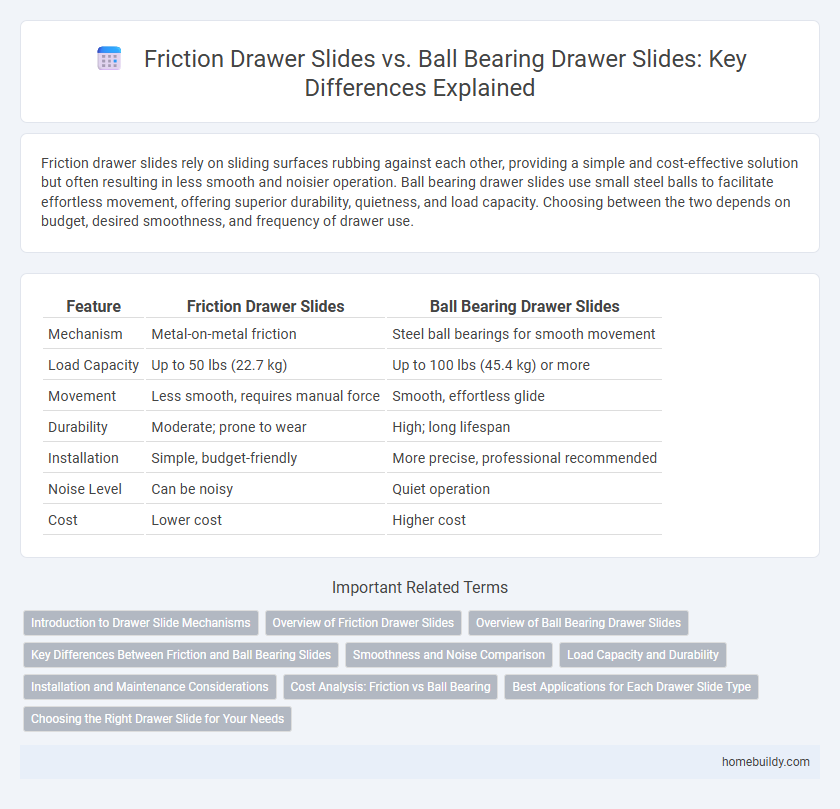Friction drawer slides rely on sliding surfaces rubbing against each other, providing a simple and cost-effective solution but often resulting in less smooth and noisier operation. Ball bearing drawer slides use small steel balls to facilitate effortless movement, offering superior durability, quietness, and load capacity. Choosing between the two depends on budget, desired smoothness, and frequency of drawer use.
Table of Comparison
| Feature | Friction Drawer Slides | Ball Bearing Drawer Slides |
|---|---|---|
| Mechanism | Metal-on-metal friction | Steel ball bearings for smooth movement |
| Load Capacity | Up to 50 lbs (22.7 kg) | Up to 100 lbs (45.4 kg) or more |
| Movement | Less smooth, requires manual force | Smooth, effortless glide |
| Durability | Moderate; prone to wear | High; long lifespan |
| Installation | Simple, budget-friendly | More precise, professional recommended |
| Noise Level | Can be noisy | Quiet operation |
| Cost | Lower cost | Higher cost |
Introduction to Drawer Slide Mechanisms
Friction drawer slides operate through resistance between surfaces, offering smooth yet controlled motion without additional components. Ball bearing drawer slides utilize rolling steel balls within a track system, providing enhanced durability and effortless glide for heavier loads. Understanding these mechanisms helps in selecting the appropriate drawer slide based on load capacity and intended use.
Overview of Friction Drawer Slides
Friction drawer slides operate through a simple mechanism where metal or polymer surfaces rub against each other, creating resistance that holds the drawer in place without additional hardware. These slides are typically cost-effective and easy to install, making them suitable for light to moderate drawer usage in residential and office furniture. However, friction slides often lack the smoothness and durability of ball bearing slides, resulting in increased wear over time and limited load capacity.
Overview of Ball Bearing Drawer Slides
Ball bearing drawer slides feature precision steel ball bearings that enable smooth, quiet, and efficient drawer movement, supporting heavier loads compared to friction slides. These slides offer enhanced durability and stability, making them ideal for high-use applications such as kitchen cabinets and office furniture. Their superior load capacity and low-maintenance design provide long-lasting performance and consistent drawer operation.
Key Differences Between Friction and Ball Bearing Slides
Friction drawer slides operate on sliding surfaces that create resistance, resulting in quieter but less smooth movement, while ball bearing drawer slides utilize steel balls to reduce friction and provide smoother, more durable operation ideal for heavy loads. Friction slides typically have lower load capacities and shorter lifespans compared to ball bearing slides, which support higher weight and withstand frequent use without wear. Additionally, ball bearing slides offer full extension and easier installation, making them a preferred choice for high-performance drawer systems.
Smoothness and Noise Comparison
Ball bearing drawer slides provide superior smoothness and quieter operation compared to friction drawer slides due to their precision-engineered steel ball bearings that reduce resistance and vibration. Friction drawer slides tend to produce more noise and require more effort to open and close since they rely on metal-on-metal contact without rolling elements. For applications demanding consistent quietness and effortless gliding, ball bearing slides are the optimal choice.
Load Capacity and Durability
Ball bearing drawer slides offer higher load capacity, typically supporting weights up to 150 pounds or more, making them suitable for heavy-duty applications. Friction drawer slides generally have lower load ratings, often around 50 to 75 pounds, limiting their use to lighter or medium-weight drawers. In terms of durability, ball bearing slides provide smoother operation and longer lifespan due to reduced friction and wear, while friction slides may wear faster and require more maintenance under heavy or frequent use.
Installation and Maintenance Considerations
Friction drawer slides require precise alignment during installation to ensure smooth operation and often need periodic lubrication to maintain functionality, making them more maintenance-intensive. Ball bearing drawer slides offer straightforward installation with adjustable mounting options and minimal maintenance due to sealed bearings that resist dirt and debris. Choosing between the two depends on the ease of installation preferences and the desired frequency of maintenance for long-term performance.
Cost Analysis: Friction vs Ball Bearing
Friction drawer slides typically cost less upfront due to simpler construction and lower manufacturing expenses, making them ideal for budget-conscious projects. Ball bearing drawer slides involve higher initial costs, reflecting precision engineering and superior materials that deliver smoother operation and longer lifespan. Evaluating long-term value, ball bearing slides often reduce maintenance and replacement expenses, offsetting the initial investment for high-use or heavy-load applications.
Best Applications for Each Drawer Slide Type
Friction drawer slides are ideal for lightweight applications such as small toolboxes, kitchen drawers, or craft storage, where smooth operation is less critical and cost efficiency is prioritized. Ball bearing drawer slides provide superior durability and smoothness, making them best suited for heavy-duty furniture, industrial cabinets, and high-traffic environments that require full extension and load-bearing capacity. Selecting the appropriate drawer slide type depends on weight capacity, frequency of use, and desired slide smoothness.
Choosing the Right Drawer Slide for Your Needs
Friction drawer slides rely on direct contact between surfaces, providing smooth but often slower movement suitable for lightweight applications and budget-friendly options. Ball bearing drawer slides offer enhanced durability and smoother, quieter operation through steel balls rolling in track channels, ideal for heavy-duty drawers and frequent use. Selecting the right drawer slide depends on load capacity, drawer size, and desired ease of motion, with ball bearing slides favored for high performance and friction slides preferred for simplicity and cost-effectiveness.
Friction drawer slides vs Ball bearing drawer slides Infographic

 homebuildy.com
homebuildy.com